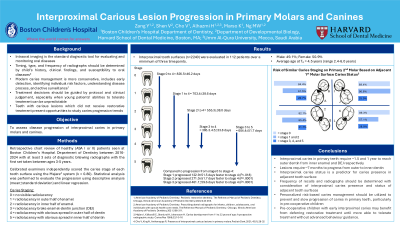Caries
8 - Interproximal Carious Lesion Progression in Primary Molars and Canines


Yan Ning Zang, DDS (she/her/hers)
Resident
Boston Children’s Hospital, Boston, MA
Harvard School of Dental Medicine
Brookline, Massachusetts, United States
Man Wai Ng, DDS, MPH (she/her/hers)
Dentist in Chief
Boston Children's Hospital
Boston Children's Hospital
Brookline, Massachusetts, United States
Isabelle Chase, DDS
Director, Postgraduate Pediatric Dentistry
Boston Children's Hospital
Harvard School of Dental Medicine
Brookline, Massachusetts, United States
Presenting Author(s)
Research Mentor(s)
Program Director(s)
Purpose: To assess the rate of interproximal caries progression in primary molars and canines.
Methods: Bitewing radiographs were reviewed of patients seen in a children’s hospital dental clinic between 2016-2024 who have at least 3 sets obtained over a 3-year period, with the first set taken at age 3-5 years. Calibrated examiners independently scored the caries stage of each tooth surface using the Mejare system (k = 0.80). Statistical analysis was performed to evaluate the progression using descriptive analysis (mean±standard deviation) and linear regression (coefficient).
Results: Tooth surfaces (n=2240) were evaluated in 112 healthy (ASA I and II) patients over a minimum of three timepoints. Surfaces with caries were associated with adjacent surfaces with caries, whereas caries-free surfaces (stage 0) were adjacent to other caries-free surfaces. Stage 0 surfaces that later developed caries required 826.5±42.6 days to progress to outer dentin (stage 4), whereas caries in the outer half of enamel (stage 1) progressed 122.9±51.5 days faster to stage 4 (P=.018), caries present in stage 2 (inner enamel) progressed 271.0±51.7 days faster to stage 4 (P < .0001), and caries at the enamel-dentin junction (stage 3) progressed 461.1±59.6 days faster to stage 4 (P < .0001). Furthermore, caries at stage 3 progressed to inner dentin (stage 5) over an average of 604.4±51.7 days.
Conclusions: These findings describe the progression of caries in primary teeth. Clinicians should implement personalized approaches for caries management strategies with consideration of caries presence, rate of progression, and surfaces involved.
Identify Supporting Agency and Grant Number:

.jpg)